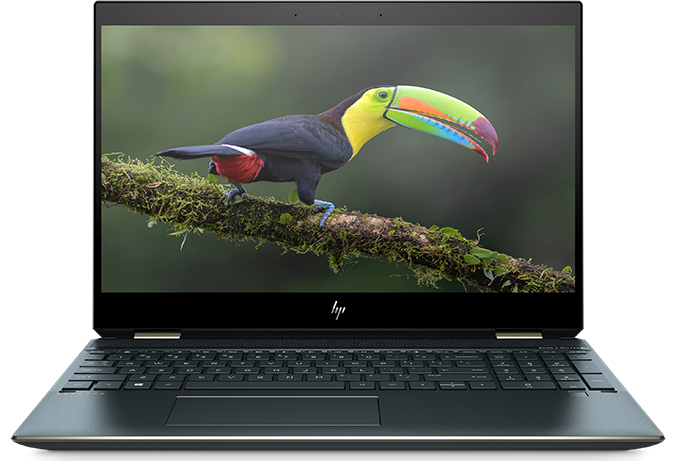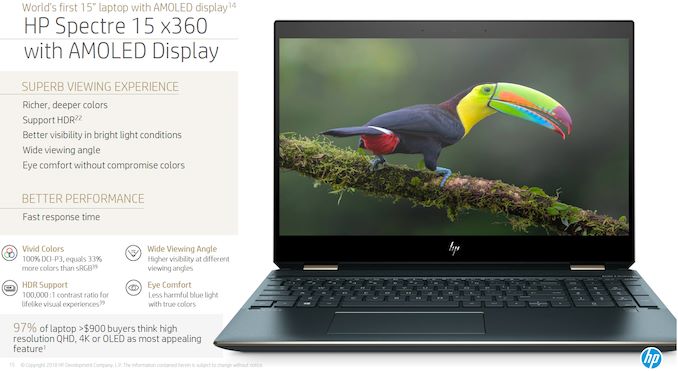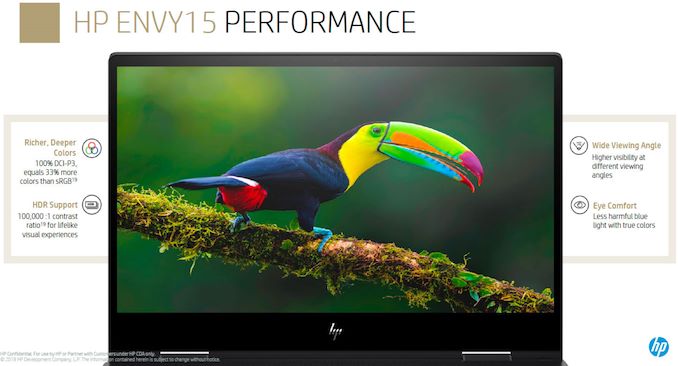HP to Introduce AMOLED Envy and Spectre Laptops in April
by Anton Shilov on March 28, 2019 6:00 PM EST- Posted in
- Laptops
- HP
- AMOLED
- Convertible
- Notebooks
- OLED
- Spectre x360
- Envy x360

HP is on track to start sales of laptops featuring a 15.6-inch AMOLED display in April, the company said recently. The first systems to get the innovative screens will be the company’s Envy and Spectre convertible notebooks that will first be available in Europe and the US.
HP introduced the Spectre x360 15, its first laptop with a 15.6-inch AMOLED display, back at CES 2019. Last week the company disclosed that apart from the said machine, it will also offer a premium version of its Envy x360 15 featuring the same panel. HP will reveal exact specifications of its ultra-thin 15.6-inch laptops with AMOLED displays at a later date, the only thing we do know about them at this time is that they will be based on Intel’s Core ‘Whiskey Lake’ CPUs. Meanwhile, given premium pricing of AMOLED screens, it is reasonable to expect these machines to be offered with other high-end components (GPU, SSD, Wi-Fi, etc.).
The manufacturer plans to start selling the HP Spectre x360 15 convertible via HP.com on April 19 with retail availability through Best Buy expected in May. The Envy x360 15 convertible laptop will be available next month in Europe first, whereas its US launch date will be announced separately, the company said.
Interestingly, HP also has not published many details about the 15.6-inch AMOLED panel it plans to use. So far the only company that has announced a 15.6-inch AMOLED display for laptops so far is Samsung Display. This panel has a 3840×2160 resolution, a brightness level ranging from 0.0005 to 600 nits, a dynamic contrast ratio of 120,000:1, a very low response time, and wide horizontal viewing angles. The screen can reproduce 100% of the DCI-P3 color gamut, which is considerably more accurate when compared to LCDs available today. Furthermore, the monitor carries VESA’s DisplayHDR True Black badge thus supporting at least HDR10 spec. Keep in mind though that HP might use a different panel or different grade of panel.
Related Reading:
- HP at CES 2019: HP Spectre x360 15 Gets AMOLED Display
- Samsung Unveils 15.6-Inch Ultra-HD OLED Display for Laptops
- Lenovo at CES 2019: Yoga C730 Gets AMOLED Display
- Dell at CES 2019: Alienware 55-Inch 4K 120 Hz OLED Gaming Monitor Showcased
Source: HP












41 Comments
View All Comments
mr_tawan - Thursday, March 28, 2019 - link
While they do look ugly, I think they have function to serve. The top of the screen has web cam and a mic array. The bottom of the screen... help lifting the screen up a little bit so your hands are blocking the screen. Well that are some reasoning I can think of lol.I personally don't like the phone that has super narrow bezel on the top/bottom. Just find it difficult to hold when watching video or playing games. Without larger bezel, it has to be hold on the side which I find it a little awkward. It does look good, I admit. If it's just a monitor then I'd have no objections.
Dizoja86 - Thursday, March 28, 2019 - link
I have the 2018 HP Spectre with the same bezels, and I was initially skeptical, but I love it at this point. The bezels are under the same piece of glass as the rest of the display, so it is all a single surface. I also actually purchased this laptop for the 2-in-1 functionality, and the bezels make it far easier to use as a tablet. The bottom bezel also keeps your hands from getting in the way of the screen while you're typing if you're like me and actually use the laptop in your lap or in bed.Samus - Friday, March 29, 2019 - link
Aside from what other people have said, the other reason the display is lifted above the hinges has to do with heat dispersion. The fans blow heat up onto the screen and direct it at this bezel below the screen to effective deflect the heat away from the surface - Apple was the first manufacture to do this with the Macbook a decade ago in order to remove all vents from the bottom plate of the machine.I've also repaired screens and noticed a lot of structural reinforcement in the bottom bezel where the hinges meet, and sometimes a X brace behind the panel. I think the strategic position of the panel could have to do with durability.
Tams80 - Friday, March 29, 2019 - link
"The bezels are stupid. They should be almost gone."Me: "Why?"
"Because they're ugly."
Me: *how far can this species fall?*
Valantar - Friday, March 29, 2019 - link
In a metal notebook there are reasons (beyond cameras): WiFi and Bluetooth (and possibly 4G) antennas. These need a certain amount of non-obstructed area to work. Still, these displays could have been taller even accounting for that. The issue is that making the notebook 16:9 would mean terrible ergonomics (small touchpad, useless wrist rest) and likely a too-small battery (rest of hardware is mostly fixed size) - and there are barely 16:10 display panels being made any more (with Apple's panels being the exception).Still, in time I hope laptops in general move to 3:2 as a standard aspect ratio. It's far better suited to what laptops are used for (web browsing and office work), has a good balance of width to height, and is a good balance in terms of ergonomics for the rest of the device.
Spunjji - Sunday, March 31, 2019 - link
I'm very much in agreement here. The thing is, panel manufacturers mostly make 16:9 displays these days - and having a custom panel made for your line of notebooks adds cost that most OEMs are loathe to take on.Vitor - Thursday, March 28, 2019 - link
I still find 4k overkill for notebooks. I dream of a 2560x1600, I miss 16:10.SaturnusDK - Thursday, March 28, 2019 - link
I agree. 13.3" for my 2560x1440 screen is a tad too small for my taste as I'm pushing 50. 15.6" would be perfect for 2560x1440 but 4K? No. That's way too small a screen for that.TristanSDX - Friday, March 29, 2019 - link
4K / 8K is for quality, not quantity, so many people do not understand this. Use screen scalingSaturnusDK - Friday, March 29, 2019 - link
And many people do not understand that many professional programs do not work with screen scaling. Jeez.